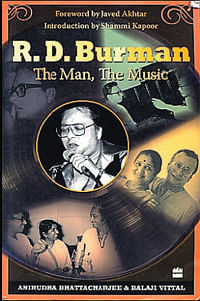Pancham-Naama

Incidentally, the nickname Pancham was given to R D Burman by Ashok Kumar. It is by no means a laudatory work, if one looks at the drawbacks and weaknesses that the authors highlight, even accusing the composer of using the same tunes for different films with little or no variation.
Yet, there is no denying the fact that Pancham was “a milestone in music,” who “urbanised Hindustani music and brought it closer to world music,” “continues to be the most ‘remixed’ Indian composer ever,” and “what Rahman is doing today with so many more gizmos and recording instruments and electronics, Pancham did 35 years back,” to quote his friend Randhir Kapoor. Pancham was no doubt a genius, but like any other artiste in the bad, mad world of Hindi cinema, he too allowed himself to be a part of the blind race, because people only worship the rising sun.
It is paradoxical how little say a composer came to have, unlike the 60s and 70s when the music director’s was the last word. In the 80s, it was the director who decided what he wanted. To quote Amit Kumar, “Often, the best tunes Pancham created would be rejected by the producer.” And that included makers like Ramesh Sippy and Vidhu Vinod Chopra who had originally rejected the tune of Kuch no kaho, kuch bhi na kaho.
From recording his first song at the tender age of nine, in the 32 years of trendsetting music, he scored music for over 330 Hindi films: 192 released and nearly 40 unreleased, apart from 40 in Bengali and other languages. He died young, barely 54, but not before signing off with the music of 1942 A Love Story, rightly celebrated as “R D Burman’s greatest work,” though there were also others, like Teesri Manzil, Sholay, Namak Haraam, Kati Patang, Aandhi, especially the song, Tere bina zindagi bhi lekin zindagi toh nahin, “the monumental success of the song can be gauged from the response it gets even today…on You Tube…around 3.5 million, definitely the highest for any Hindi film song.”
Pancham’s genius also lay in the fact that he could produce music from almost anything that produced sound. “Using uncommon instruments to extract diverse sounds, taking risks with unfamiliar instruments, using natural sounds within tracks and experimenting with rhythm and mixing had become Pancham’s favourite plaything.” Almost anyone who came in contact with him would vouch for that.
While concluding his short introduction to the book, Shammi Kapoor says: “His achievements need to be documented. His story needs to be told.” And that is precisely what Anirudha Bhattacharjee and Balaji Vittal have done with remarkable insight, unsparingly and honestly. They have brought to life “Pancham’s mystique.” Although the authors give due consideration to R D Burman, highlighting both strong points and weaknesses, one wished they had been a little more generous to him.
A brilliantly researched, analysed, argued, critically examined comprehensive book on the life, times, and music of R D Burman, the foremost rebel music composer in Bollywood from 1962 to 1994, when he succumbed to pressures of the heart. The book is not without errors and drawbacks, but they are miniscule as compared to its enviable merits. The reference to ragas and other technical phraseology that Pancham deployed to compose some of his most memorable songs would make the lay reader somewhat uncomfortable, but that, one also supposes, is inevitable. The book is also a treasure house of seminal information on lesser known facts that will serve as footnotes for further research on lesser known aspects of mainstream Hindi cinema.
Deccan Herald is on WhatsApp Channels| Join now for Breaking News & Editor's Picks